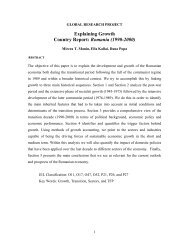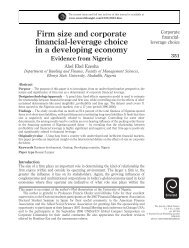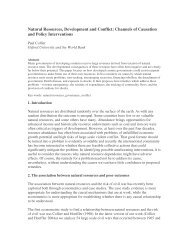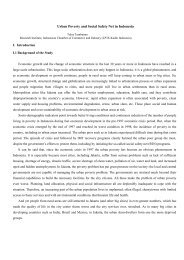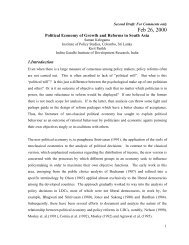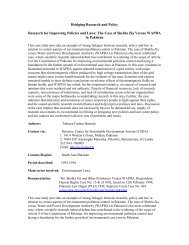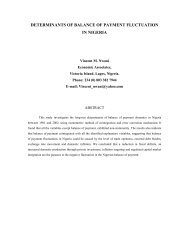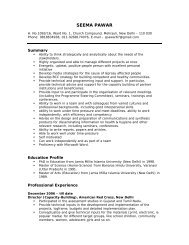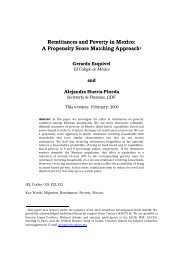Micro Finance-A Magic Wand for Poverty Alleviation - Global ...
Micro Finance-A Magic Wand for Poverty Alleviation - Global ...
Micro Finance-A Magic Wand for Poverty Alleviation - Global ...
You also want an ePaper? Increase the reach of your titles
YUMPU automatically turns print PDFs into web optimized ePapers that Google loves.
Published in IEA’s Conference Volume (90 th Conference) 1MICRO FINANCE- A MAGIC WAND FOR POVERTY ALLEVIATION:A CASE STUDY OF SGSYD.C. PATHAK, S.K. PANT ∗“<strong>Poverty</strong> is the worst <strong>for</strong>m of violence”M.K. GandhiIIntroduction:The objective of this paper is to analyse the socio-economic impact ofmicrofinance on rural poverty alleviation. For this purpose, we shall analysethe socio-economic impact of SwarnaJayanti Gram Swarojgar Yojna onpoverty alleviation in Mariahu block of District Jaunpur in Uttar Pradesh.The structure of the paper is as follows: Section II explains concepts andmeasures of poverty. Section III provides a brief review of literature onIndian planning experience with poverty reduction. This section also tries toexplain the basic difference between <strong>Micro</strong> Credit and <strong>Micro</strong> <strong>Finance</strong>.Section IV presents a comparative picture <strong>for</strong> India and Uttar Pradesh on thebasis of some income and non-income indicators of poverty. Section Vanalyses the impact of SGSY on poverty alleviation in the Mariahu block ofdistrict Jaunpur. It uses the same set of indicators that were used in SectionIV. Section VI draws together the conclusions to suggest some appropriatepolicy measures.II<strong>Poverty</strong>: Concepts and Measures:<strong>Poverty</strong> is a socio-economic phenomenon in which a section of the society isunable to fulfil even its basic necessities of life. In general, those who areunable to fulfil their minimum nutritional needs due to lack of income areconsidered to be poor.<strong>Poverty</strong> could be relative (He has two cars and I only one…sic…) aswell as absolute (I don’t have enough to have even one square meal). In∗Mr. D.C. Pathak is an ICSSR-Doctoral Fellow at the G.B. Pant Social Science Institute,Allahabad. Dr. S.K. Pant is Thesis-supervisor of the first author and a Reader in Economicsat the same Institute.We are grateful to Mr. Sandeep of this Institute <strong>for</strong> his excellent assistance withcomputer.
Published in IEA’s Conference Volume (90 th Conference) 2developing countries like India, relative poverty is not taken to be a causeof concern but absolute poverty is.The discourse on poverty largely revolves around the notion of apoverty line: a critical threshold of income, consumption, or moregenerally, access to goods and services below which the individuals aredeclared to be poor (Ray, 2002). To determine poverty line based onnutritional requirements, the minimum physical quantities of cereals,pulses, milk, butter, etc. are determined <strong>for</strong> a subsistence level and thenusing price quotations, the physical quantities are converted into monetaryterms. Aggregating these monetary terms <strong>for</strong> various physical quantities ofcommodities, the poverty line is thereby drawn. People whose income isbelow poverty line are said to be poor. The most common measure ofpoverty is the Head-Count ratio, defined as the percentage of populationliving below the poverty line.In 1979, the Task Force on Projections of Minimum Needs andEffective Consumption Demand constituted by the Planning Commission ofIndia, defined the poverty line <strong>for</strong> the country as a per capita consumptionlevel, which meets the average per capita daily requirement of 2400 kcal inthe rural areas and 2100 kcal in the urban areas, along with a minimumlevel of non-food expenditure. An average food basket was chosen whichprovides the required calorie and using the 28 th round NSS data, the TaskForce estimated that consumer expenditure of Rs. 49.09 per capita permonth, in 1973-74, met the calorie requirement in rural areas. Thismonetary equivalent of the calorie requirement was set as the rural povertyline and those with per capita expenditure below this level were defined asthe poor. This was common <strong>for</strong> all states of India.In 1993, the Planning Commission set up another Task Force, underchairmanship of Prof. Lakadwala to remove the anomaly of a commonpoverty line <strong>for</strong> all states of India. The Lakadwala Committee retained thesame consumption basket of 1973 and estimated separate poverty lines <strong>for</strong>each state.The pioneering work by Prof. Amartya Sen and Prof. MarthaNussbaum put <strong>for</strong>ward another way of analysing the poverty. They identified
Published in IEA’s Conference Volume (90 th Conference) 3it as a lack of capabilities and freedoms. The conceptual foundations of theCapability Approach (CA hence<strong>for</strong>th) can be found in Sen’s critique oftraditional welfare economics, which typically conflate well-being witheither opulence (income, commodity command) or utility (happiness, desirefulfilment). Sen makes a distinction between commodities, humanfunctioning/capability and utility which could be summarised as follows:CommodityCapability (tofunction)Figure 1: Relation between commodity and utility (Clark, 2005)Thus, the lack of command over commodities (entitlement) leads todecline in the levels of utility and vice-versa.<strong>Poverty</strong> invariably affects all the indicators of human developmentindex. Thus, we should look at a comprehensive picture inclusive of bothincome and non-income indicators while analysing overall poverty scenario.This paper uses both income-poverty measures and social indicatorswhich affect the capability of individual and utilises the field data to seechange in these parameters in the block sampled <strong>for</strong> the study.Indian Planning Experience with <strong>Poverty</strong> Reduction:IIISince the inception of economic planning in India, ef<strong>for</strong>ts have been madein successive plans to mitigate the incidence of poverty. Depending on thedominant development paradigms of the age, India has tried variousstrategies <strong>for</strong> addressing the issue of poverty. Some of them could besummarised as the Community Development, Trickle Down, Basic Needs,Human Resource Development, Labour-Intensive growth with targetedprogrammes and empowerment and enhancing security, to name a few.Despite all these ef<strong>for</strong>ts, there has been no conspicuous change at thepoverty front: though the relative poverty has fallen marginally, theabsolute poverty is still alarmingly high.Function(ing)Utility (e.g.happiness)The growth strategy followed in 1960s and 1970s had presumed that ahigher rate of economic growth, through “Trickle Down” effect, wouldenhance the standard of living of the poor. But the “Trickle Down” concepthas failed to precipitate. There<strong>for</strong>e, during the 1970s the Government of
Published in IEA’s Conference Volume (90 th Conference) 4India had initiated Anti-<strong>Poverty</strong> Programs. Since the Sixth Plan (1980-85), amore direct approach was adopted. “The 'direct' approach to povertyreduction emphasises that it is essential to directly provide the poor withadequate purchasing power, other assets or access to food grains atsubsidised prices to meet their minimum consumption requirement”(Nayyar, 2005). “Bypassing the traditional growth approach, special <strong>Poverty</strong><strong>Alleviation</strong> Programmes (PAPs) were to be implemented in order to reducepoverty to 30 per cent by 1985. The schemes involved income generation <strong>for</strong>the poor, meeting their minimum basic needs (like rural drinking watersupply, primary education, primary health care facilities, ruralinfrastructure and electrification, low cost housing and other socialservices), and provide specific support <strong>for</strong> the backward areas”(Stuijevenberg, 1996). Programmes such as these were considered an acutenecessity because there has been a gradual decline in the incidence ofpoverty, in absolute terms 277 million persons were still living below thepoverty line, facing conditions of ill health and short life expectancy(Planning Commission, 1996-97). Lack of basic educational skills and accessto the means of production, prevented the masses to participate in, andderive benefit from, economic growth. Besides, households in India oftensuffered from transient rather than chronic poverty. Their economicposition also varied from year to year depending on a good or bad harvest,and within a year due to the seasonality of employment and wage earnings.The Anti-<strong>Poverty</strong> Programs (APP hence<strong>for</strong>th) could be broadly classedinto two groups: Rural Wage Employment Schemes and Rural Self-Employment Schemes. We have focussed here on Self-employmentprogrammes only.Rural Self-Employment Scheme includes an array of programmes likeIntegrated Rural Development program (IRDP), Training of the Rural Youth<strong>for</strong> self-Employment (TRYSEM), Development of Women and Children inRural Areas (DWCRA), Supply of Improved Toolkits to Rural Artisans (SITRA)and Ganga Kalyan Yojna (GKY) etc. All these programs were intended to subserve specific areas in order to prepare the rural poor <strong>for</strong> self-employmentand enable them to cross the poverty line.
Published in IEA’s Conference Volume (90 th Conference) 5The multiplicity of different programs without appropriate linkageswas one of the cardinal reasons <strong>for</strong> the underper<strong>for</strong>mance of these schemes.Concerned over the sterile per<strong>for</strong>mance of these programmes, thePlanning Commission subsequently set up a committee under thechairmanship of Prof. Hashim to review and rationalise the various centrallysponsored schemes <strong>for</strong> poverty alleviation and employment generation. TheHashim Committee recommended integration of all rural wage employmentprograms into a single scheme and rechristened it as Jawahar Gram SamridhiYojna (JGSY) and that of all rural self-employment programs into a singlescheme called Swarnajayanti Gram Swarozgar Yojna (SGSY). The presentexercise mainly focuses on the per<strong>for</strong>mance of the rural self-employmentprograms.In case of rural self-employment programs, the Hashim Committeealso recommended a concerted move from the predominantly individualbeneficiary approach to a group approach, as well as on identification ofactivity clusters <strong>for</strong> concerted action.<strong>Micro</strong> Credit and <strong>Micro</strong>finance:It has generally been observed that the poor people don’t have access tobank loans. Private money lenders charge a very high interest rates. Thismakes it difficult <strong>for</strong> poor people to access funds <strong>for</strong> starting small incomegeneration activities like sewing, buying buffalo, opening a tea stall or someother small shop. <strong>Micro</strong> Credit caters the need of people <strong>for</strong> small loans.<strong>Micro</strong> finance includes support services along with the loan component. In<strong>Micro</strong> Credit, more emphasis is placed on loans.<strong>Micro</strong>finance, thereby, opens up channels <strong>for</strong> thrift, marketassistance, technical assistance, capacity building, insurance, social andcultural programmes. Thus, <strong>Micro</strong>finance has an element of ‘Credit plus’while micro credit is ‘only credit’.<strong>Micro</strong> finance<strong>Micro</strong> creditFig. 02: <strong>Micro</strong> credit vs. <strong>Micro</strong> finance
Published in IEA’s Conference Volume (90 th Conference) 6IVIndia and Uttar Pradesh: A comparison on some selectedindicators:We are comparing India and Uttar Pradesh on both monetary and nonmonetaryindicators. For the farmer, the head-count ratio has been taken.For the non-monetary indicators, we are using Shelter and Quality ofHousing, Access to drinking water, Access to sanitation facility, and last butnot the least, Access to electricity.(a) Income:The Per Capita Domestic Product <strong>for</strong> Uttar Pradesh in 2000-01 was Rs. 5707at 1993-94 prices while the corresponding figure <strong>for</strong> India was Rs. 10306(Planning Department of UP). This shows how much the state lags fromIndia. Not only has the incidence of combined level increased from 1973-74but it has enhanced to a more acute level in urban areas (Table 1).The Table 1 gives a comparative picture of head-count rate ofpoverty in India and Uttar Pradesh:YearTable 1: Percentage of population below <strong>Poverty</strong> Line (%)Combined (Rural &Urban)Uttar IndiaPradeshUttarPradeshRuralIndiaUttarPradeshUrban1973-74 57 55 57 56 60 491987-88 42 39 39 381993-94 41 36 42 37 35 321999-00 31 26 31 27 31 24Source: Uttar Pradesh Human Development Report (vol. 1)(b) Non-Income Indicators:IndiaMeasuring household welfare in terms of consumption or income does nottake into account his assets like type of house, access to drinking water,sanitation and electricity. Since access to these assets and services is notuniversal, a household with access to these may be enjoying welfare levelquite higher than a household without access to these assets and services,though their income or consumption levels are almost similar.
Published in IEA’s Conference Volume (90 th Conference) 7(i) Shelter and Quality of Housing:In developing countries, the single most important asset owned byhousehold is often the dwelling in which they live. Hence, “the type ofdwelling in which a household lives is an important indicator of its welfarelevel” (Monitoring <strong>Poverty</strong> in Uttar Pradesh, 2006).NFHs-2 gives the data <strong>for</strong> Quality of housing according to whichduring 1998-99, at all India level, 41.4 percent of household in rural areaswere living in Kuchha house while the corresponding figure <strong>for</strong> Uttar Pradeshwas 53.2 percent.Table 2: Housing Characteristic (1998-99)Housing CharacteristicAll India Level Uttar PradeshUrban Rural Total Urban Rural TotalKachha 9.4 41.4 32.5 8.4 53.2 47.3Semi-Pucca 24.4 39.5 35.3 16.3 35.2 31.2Pucca 66.0 19.0 32.0 75.1 11.2 24.8Source: NHFS-2(ii) Access to Drinking Water:As per Census of India, if a household has access to drinking water suppliedby a tap or a hand pump/tube well situated within or outside the premises,it is considered as having access to safe drinking water.The Table 3 shows a comparative picture of India and Uttar Pradesh<strong>for</strong> access to safe drinking water. Hardly 6 percent of the rural population inthe state had access to safe drinking water source (piped water supply) to25 percent at all India level.Table 3: Sources of drinking water (1998-99)Source of drinking WaterAll India Level Uttar PradeshUrban Rural Total Urban Rural TotalPiped 74.5 25.0 38.7 42.9 5.5 13.5Hand pump 18.1 47.3 39.2 55.2 76.7 72.1Well water 6.0 23.5 18.7 1.7 15.7 12.7Surface water 0.4 3.5 2.6 0.1 2.0 1.6Other 1.0 0.7 0.8 0.1 0.1 0.0Source: NFHS-2(iii) Sanitation Facilities:Welfare of Households is also affected by their access to sanitation facility.Availability of sanitary environment reduces the risk of contamination ofwater bodies. The table 4 shows the access to sanitation facility <strong>for</strong> all-Indiaand Uttar Pradesh level.
Published in IEA’s Conference Volume (90 th Conference) 8Table 4: Access to sanitation facility (1998-99)Sanitation FacilityAll India Level Uttar PradeshUrban Rural Total Urban Rural TotalFlush toilet 63.9 8.8 24.0 38.8 2.5 10.2Pit toilet/latrine 16.8 10.0 11.9 44.6 8.6 16.3Other 0.0 0.1 0.1 0.1 0.3 0.2No Facility 19.3 81.1 64.0 16.5 88.6 73.3Source: NFHS-2And if we take the data from PSMS-II, in 2002-03, 84.3 percent of ruralpopulation doesn’t have access to latrines.(iv) Access to Electricity:An important infrastructural service provided by government is electricity.Access to electricity affects life of people in several ways. The farmer canget an electricity-operated pump set which can be cheaper compared to oneoperate by diesel. This will reduce his costs. Availability of electricity willbe helpful <strong>for</strong> village children to study. Table 5 shows access to electricityat all-India and Uttar Pradesh level. Hardly 23 percent of rural household ofthe state have access to electricity as compared to about 49 percent at theall-India level.Table 5: Access to electricity (1998-99)All India LevelUttar PradeshElectricity Urban Rural Total Urban Rural TotalYes 91.3 48.1 60.1 87.5 22.8 36.6No 8.7 51.9 39.9 12.5 77.2 63.4Source: NFHS-2Socio-Economic Impact of SGSY:VUttar Pradesh has been divided into four regions namely, Western, Central,Eastern, and Bundelkhand. District Jaunpur comes under Eastern region.Further, district jaunpur has been divided into six tehsils namely, Jaunpur,Mariahu, Shahganj, Kerakat, Machhalishar, and Badlapur. Mariahu tehsilconsists of twenty one blocks. We have studied impact of SGSY in Mariahublock.(a) Impact on Income:The study couldn’t find any significant impact of SGSY on income ofbeneficiaries in the Mariahu block. The Mann-Whitney test comes to be
Published in IEA’s Conference Volume (90 th Conference) 9insignificant <strong>for</strong> the variables ‘Status of the Respondent: SHG or Non-SHG’and ‘What has been the change in Income <strong>for</strong> Households from 1999 to2006’.What has been thechange in Income <strong>for</strong>Households from 1999to 2006Table 6: NPar TestsMann-Whitney TestRanksStatus of the RespondentSHG or Non-SHGN MeanRankSum ofRanksNon-SHG 50 53.63 2681.50SHG 50 47.37 2368.50Total 100reasons:Test Statistics (a)What is the change in Income <strong>for</strong>Households from 1999 to 2006Mann-Whitney U 1093.500Wilcoxon W 2368.500Z -1.085Asymp. Sig. (2-tailed) .278a Grouping Variable: Status of the Respondent SHG or Non-SHGThe following additional findings may indicate toward the plausible64 percent of beneficiaries have reported that they have not receivedany kind of training in the programme.76 percent of the beneficiaries were engaged in individual activities.Only 8 percent were involved in some kind of group activity, while 16percent had not started any activity at all.Only 42 percent of beneficiaries have created any asset out of theSGSY-loan which was operational at the time of survey. 4 percentwere not operational while 28 percent hadn't created any asset at all.40 percent of respondents said that they would not <strong>for</strong>m an SHG infuture, if given opportunity.There has been one very interesting finding from field data. A pointbiserial1 correlation between the sex of the respondent and the change in
Published in IEA’s Conference Volume (90 th Conference) 10income was found to be statistically significant at 0.01 level (2-tailed). Thetest results are given below:Table 7: Point-biserial Correlation between Sex of the Respondent and theChange in Income from 1999-2006Sex of theRespondentChange in Income <strong>for</strong>Households from 1999 to 2006Sex of the Respondent Pearson Correlation 1 -.408**Sig. (2-tailed) . .000What is the change inIncome <strong>for</strong> HouseholdsN 100 100Pearson Correlation -.408** 1Sig. (2-tailed) .000 .from 1999 to 2006 N 100 100** Correlation is significant at the 0.01 level (2-tailed).It has often been pointed out in many studies that women-SHGsper<strong>for</strong>m better than those <strong>for</strong>med by men. We attempted to analyse toanalyse whether there has been any significant relationship between thenumber of women members in a SHG and the change in Income during 1999-2006. For this we per<strong>for</strong>med a Pearson correlation test <strong>for</strong> the ratio ofwomen members with the total number of members in a SHG. The resultingcorrelation coefficient was found to be statistically significant at 0.01 level(2-tailed). The Table 8 summarises the result:Status of theRespondentSHG or Non-SHGSHGWhat is the change inIncome <strong>for</strong>Households from 1999to 2006Ratio of Femalemember to Malemembers in a SHGTable 8: Correlations** Correlation is significant at the 0.01 level (2-tailed).Change in Income<strong>for</strong> Householdsfrom 1999 to2006Ratio of Femalemember toTotal membersin a SHGPearson Correlation 1 -.643**Sig. (2-tailed) . .000N 50 50Pearson Correlation -.643** 1Sig. (2-tailed) .000 .N 50 50But contrary to other studies, we found that the sign of the Pearsoncorrelation coefficient (r) was negative. This indicates a negativerelationship between the ratio of women members to total members in aSHG and the change in income from 1998 to 2006. A plausible explanation tothis finding could be as follows: Most of the women members in a SHG wereworking as a proxy <strong>for</strong> their husband. Since the officials emphasised on<strong>for</strong>mation of women SHGs, or since the male members were already
Published in IEA’s Conference Volume (90 th Conference) 11engaged in some kind of gainful employment, they made theirwives/mothers/daughters a member of the SHG and used the loan <strong>for</strong> theirown purpose. This had two-fold effect: first, the number of womenmembers increased significantly in a SHG, second, the income couldn'tincrease significantly as the loan was not used properly.Despite this finding, we also came across some women SHGs thatwere very well functioning and the women showed great enthusiasm. TheseSHGs were the best per<strong>for</strong>mers in the study field.Box 1: Gender MattersWhy women-SHGs per<strong>for</strong>m better?While collecting primary data <strong>for</strong> this research, the talk with several womenheads of SHG on why their SHGs are working better than those <strong>for</strong>med bymen. They blamed inflated egos of men <strong>for</strong> this. One SHG-head told us thatshe never hesitates to go and collect the savings of members from their homeon the date they have to deposit the instalment of the loan taken. Even if amember is unable to pay back her share of the instalment, others made up<strong>for</strong> her and she repays them later. In this way the instalment is deposited attime. This is not so in case of men-SHGs.(b) Impact on Non-Income Indicators:(i) Shelter and Quality of Housing:The data shows that the change in type of house was more prominent <strong>for</strong>the Non-SHG group than <strong>for</strong> the SHG group. The reason may be found in thefact that the SHG people had been at a better position to begin with. Andthey were still better at the absolute number but the change was more infavour of Non-SHG people. This may be partly due to the fact that SHGshave not been able to influence the income change significantly so far.Table 9: Type of House: Mariahu BlockStatus of the household: SHG or Non-SHGType of HouseNon- Non- ∆Non- SHG1999 SHG2006 ∆SHGSHG1999 SHG2006 SHGPucca 14 46 32 30 56 26Half Pucca 6 10 4 18 20 2Kuchha 80 44 -36 52 24 -28Total percent 100 100 100 100 100 100Source: Filed dataThe figures are percentages within the group.
Published in IEA’s Conference Volume (90 th Conference) 124032302620Percentage Change100-104 2∆Non-SHG∆SHG-20-30-28-40Pucca Half Pucca KuchchaType of House-36Fig.1: Change in Housing Condition: Mariahu (1999-2006)(ii) Access to Drinking Water:The Table 10 shows the change in scenario of drinking water. The SHGs werebetter off to begin with as 42 percent of them had own hand pump,compared to 24 percent <strong>for</strong> the Non-SHG. They also faired well as thepercentage change in favour of own hand pump was also more <strong>for</strong> SHGs. Theplausible reason may be two-fold: either the SHGs were quite aware groupwho were conscious to provide safe drinking water to their family, or theSHGs were well-off than Non-SHGs since beginning and figured in the BPLlist erroneously. Further analysis of data is needed to reach at a concreteconclusion. The good news, however, was that dependence on wellscompared to all sources was decreasing in both SHGs and N0n-SHGs.Table 10: Change in Sources of drinking water (1999-2006)Source ofStatus of the Respondent SHG or Non-SHG (%)Drinkingwater Non-SHG Non-SHG2006 ∆Non-SHG SHG SHG2006 ∆SHGOwnHandpump 24 36 12 42 56 14PublicHandpump 10 32 22 8 24 16Well 64 30 -34 50 20 -30Others 2 2 0 0 0 0Source: Field dataThe figures are percentages within the group.
Published in IEA’s Conference Volume (90 th Conference) 13302220121416100 0Percentage change0-10∆Non-SHG∆SHG-20-30-30-34-40Own Handpump Public Handpump Well OthersWater sourceFig.2: Change in Sources of Drinking Water: Mariahu (1999-2006)(iii) Sanitation Facilities:The Access to sanitary facilities was comparatively better <strong>for</strong> SHGs to beginwith and it improved more than that <strong>for</strong> the Non-SHGs. This may again bedue to the fact that some well-off people have got selected in SHGs byofficials due to erroneous list. The only exception was that 10 percent ofthe Non-SHGs respondents were having access to public toilet in 1999, whilenone of the SHGs respondent had this facility.Table 11: Change in Access to Sanitation Facilities (1999-2006)Status of the Respondent SHG or Non-SHG (%)Sanitation FacilityNon- Non- ∆Non-SHG1999 SHG2006 SHG SHG1999 SHG2006 ∆SHGFlush Toilet 0 2 2 2 6 4NoFacility/Bush/Field 90 92 2 98 94 -4Public Toiletprovided bygovernment 10 6 -4 0 0 0Source: Field dataThe figures are percentages within the group.
Published in IEA’s Conference Volume (90 th Conference) 14443222Percentage Change10-10∆Non-SHG∆SHG-2-3-4-4 -4Flush Toilet No Facility/Bush/Field Public Toilet provided bygovernmentSanitation FacilityFig.3: Change in Access to Sanitation Facility: Mariahu (1999-2006)(iv) Access to Electricity:Most of the SHGs respondents were having access to electricity, both legaland illegal, in 1999 than their Non-SHGs counterparts. This indicates theirhigh level of awareness; though negative awareness in case of ill-legalconnections. Also the change is much more pronounced <strong>for</strong> SHGs respondentthan Non-SHGs respondent. The study further shows that about 2 percent ofSHGs respondent had also moved away from Ill-legal connection to legal one(may be because of pressure from peers).Table 12: Change in Access to Electricity (1999-2006)Status of the Respondent SHG or Non-SHG (%)Type ofconnectionNon- Non- ∆Non-SHG1999 SHG2006 SHG SHG1999 SHG2006 ∆SHGNo Connection 68 60 -8 46 42 -4LegalConnection 2 2 0 12 18 6Ill-LegalConnection 30 38 8 42 40 -2Source: Field dataThe figures are percentages within the group.
Published in IEA’s Conference Volume (90 th Conference) 1588664Percentage Change20-20-2∆Non-SHG∆SHG-4-4-6-8-8No Connection Legal Connection Ill-Legal ConnectionType of ConnetionFig.10: Change in Access to Electricity: Mariahu (1999-2006)(c) Other benefits due to SGSY (Spin-Off Effects):(i) Saving on interest paid to loans:Prior to joining the SGSY, the prime lending source <strong>for</strong> the villagers was thevillage money lender who charged exorbitant rate of interest. About 86percent of respondents (including both SHGs and Non-SHGs) reported thatthey used to borrow from village money lenders. However, after joining aSHG, they could get loans at 1 percent per month while it used to be around4 to 5 percent per month in case of money lenders. Even the Non-SHGsrespondents could borrow from SHGs at considerably lower rate of interst.We could arrive at the saving on interest rates paid on loans due toSGSY by using the following <strong>for</strong>mula:RSave SGSY = Rate of interest PRIOR -Rate of interst SGSYThe Modal value <strong>for</strong> RSave sgsy from our fieled data was 5.0 whileMedian was 4.0. The mean is 3.78 which is due to the fact we have somepeople who don't take loans be<strong>for</strong>e joining SGSY (They may be either wellof<strong>for</strong> too poor to get a loan).
Published in IEA’s Conference Volume (90 th Conference) 16Table 13: Statistics <strong>for</strong> RSave SGSYThe difference in rate of interest paid be<strong>for</strong>e SHG and after SHG?NValid 100Missing 0Mean 3.7775Median 4.0000Mode 5.00We could also get similar values <strong>for</strong> those who are not a member ofany SHG under SGSY but took loans from some SHG-member. They may alsohave some saving on rate of interest to be paid on loans as the SHGs chargea bit less than the money lender to be competitive. Let's call this RSave NON-SHG. This could be calculated using the following <strong>for</strong>mula:RSave NON-SHG = Rate of interest PRIOR - Rate of interest SHGThe Modal value <strong>for</strong> RSave NON-SHG from our field data is 5.0 whileMedian is 2.0. The mean is 2.71.Table 14: Statistics <strong>for</strong> RSave NON-SHGThe saving in interest rate <strong>for</strong> Non-SHG individualsN Valid 100Missing 0Mean 2.7100Median 2.0000Mode 5.00Box 2: Wither Shylocks...!Restoring DignityAlmost all SHGs accepted that SGSY has helped them to restore their dignity as they neednot beg the village money lender any more <strong>for</strong> loans. In past, once they take loan frommoney lender, they become puppet in the hands of them. The money lender can ask them<strong>for</strong> begar or they will be threatened with demand <strong>for</strong> repaying the loans at any time. Evensometimes, they also cast their evil eyes over the women folks of the debtor. The villagemoney lender of "Mother India" used to be a reality in most parts of rural India in old days.SGSY has now enabled the SHG-members to get loans at cheaper rate of interest and no oneis going to harass them <strong>for</strong> it. Even people who have not <strong>for</strong>med a SHG under SGSY can takeloans from their nearby SHGs at rates of interest considerably lower than that from moneylenders. This is one aspect of SGSY, which is undoubtedly laudable.
Published in IEA’s Conference Volume (90 th Conference) 17IVConclusions:On the basis of analysis, the following conclusions could be drawn: The SGSY has not contributed significantly in the change in the levelof income of the beneficiaries. The reason could be several. The<strong>for</strong>emost being that there has been no infrastructural facility or anyother kind of support to the SHGs to start a viable micro enterprise.Most of the beneficiaries were encouraged to go <strong>for</strong> individual works(remember it is in contradiction with the spirit of programme as itfocuses on group approach), specially buying a cow or buffalo. Thispromoted nothing but corruption as several respondents showed theirexisting live stocks as purchased under SGSY. When a new asset wasnot created at all, how would it generate any fresh stream of income.Two, Officials have been selecting beneficiaries often based onerroneous list. There may be three plausible reasons <strong>for</strong> it: one, theyare eager to show the scheme a success (Mosley and Hulme, 1998),secondly, they get bribe <strong>for</strong> it, and the last, the beneficiariessomehow fooled the officials about their economic conditions andsurreptitiously entered the BPL list. Women have showed greater enthusiasm in the making of SHGs andthese SHGs were vibrant too. But conclusion about the relationbetween gender and significant change in income can be drawn onlyafter a more detailed analysis. Keeping in view the other findings, we can suggest that the ef<strong>for</strong>tsshould be made to check corruption in implementation of SGSY andthat women should be given more encouragement in the making ofSHGs. The analysis has also shown that SGSY has the positive impact on nonincomeindicators too. Beneficiaries have shown improvement ataccess to safe drinking water, sanitation facility, and electricity.Housing conditions have also improved.
Published in IEA’s Conference Volume (90 th Conference) 18Recommendations:We suggest including an element of public accountability in the working ofthe scheme, ensuring community involvement, bringing <strong>for</strong>th transparencyin selection of beneficiaries and sensitising the community throughappropriate policy intervention viz. stage shows, organising nukkad nataks,using radios broadcasts, door-to-door campaigns etc. on social issues couldchange the scenario significantly. The help of professional bodies withrequisite experience could also be useful.The Local college youths, especially those who have joined NSS,should be encouraged to organise one day camps at villages where they canmotivate the villages to join these schemes and also tell them theintricacies of the scheme through nukkad nataks, and also help them tolodge complaints against malfunctioning of the scheme in a proper way.These youths could also be given a basic training about using the Right toIn<strong>for</strong>mation and they should convey the same to the villagers by means ofnukkad nataks. The government should provide the youth participating insuch activities some extra credit so that they also have proper incentive <strong>for</strong>engaging in these.A radio club could be <strong>for</strong>med in each village and people could beencouraged to come and listen some programmes that spread awarenessabout government schemes.Group activities should also be promoted by officials. Trainingworkshops must be organised. If the SHGs come up with a finished product,there should be infrastructural support <strong>for</strong> its marketing.The time has come when the policy makers should realise that any<strong>Micro</strong> finance programme is not like a "Fire and Forget" kind of missile. Itneeds constant and sustained monitoring. It can also be a magic wand orjust dry twig, depending on how it was handled.
Published in IEA’s Conference Volume (90 th Conference) 19Reference:Clark, David A. (2005), "The capability Approach: Its Development, Critiquesand Recent Advances", <strong>Global</strong> <strong>Poverty</strong> Research Group, p. 3.Downloaded on June 19, 2007, link: http://www.gprg.org/pubs/workingpapers/pdfs/gprg-wps-032.pdfField, Andy (2005), Discovering Statistics Using SPSS, Sage Publication,London, p. 132.Monitoring <strong>Poverty</strong> in Uttar Pradesh, Joint Report by Directorate ofEconomics and Statistics, Planning Department, Government ofUttar Pradesh and the World Bank, June 2006, p. 52.Mosley, Paul and Hulme, David (1998), "<strong>Micro</strong> enterprise <strong>Finance</strong>: Is There aConflict Between Growth and <strong>Poverty</strong> <strong>Alleviation</strong>?" WorldDevelopment, Vol. 26, No. 5, pp. 783-90, 1998.National Family Health Survey-2: India Report, p. 36, downloaded on June30, 2007, link: http://www.nfhsindia.org/data/india/indchap2.pdfNational Family Health Survey-2: Uttar Pradesh Report: p. 28 downloadedon June 30, 2007, link: http://www.nfhsindia.org/data/up/upchap2.pdfNayyar, Gaurav (2005), "Growth and <strong>Poverty</strong> in Rural India: An Analysis ofInter-State Differences", Economic and Political Weekly, April 16,2005, pp.1631-9.Planning Department of Uttar Pradesh website, link:http://planning.up.nic.in/dev_ind/devind_main.htmRay, Debraj(2002). Development Economics, India: Ox<strong>for</strong>d University Press,Fifth Impression, p. 250.Stuijvenberg, Pieter A. Van(1996). “Structural adjustment in India-WhatAbout <strong>Poverty</strong> <strong>Alleviation</strong>?”, in Rao, C. H. Hanumantha andLinnemann, Hans(eds.), Economic Re<strong>for</strong>ms and <strong>Poverty</strong> <strong>Alleviation</strong>in India, Indo-Dutch Studies on Development Alternatives-17, SagePublications, New Delhi/Thousand Oaks/London, p.38.Uttar Pradesh Development Report, Vol. 1, p. 95, Government of India, NewDelhi, 2007.1 The Point-biserial correlation coefficient (r pb ) is used when one of thevariables is a discrete dichotomy (e.g. gender) (see Field, 2005) and theother a continuous (scale) variable.



